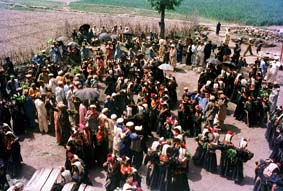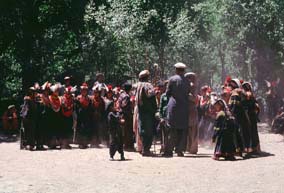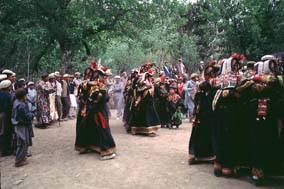|
|
Dance Songs monotonous dance songs with the drums |
|
|
|
Dance Songs monotonous dance songs with the drums |
|
 In the spring festival Joshi,
autumn festival Uchao, weddings, funerals, feasts and on many
other occasions the whole society of the Kalasha gather and
participate in a grand performance called
cha,
drajahilak and
dushak. These are set performances all
consisting of song (ghu), dance (nat) and the drums but
the details differ respectively.
In the spring festival Joshi,
autumn festival Uchao, weddings, funerals, feasts and on many
other occasions the whole society of the Kalasha gather and
participate in a grand performance called
cha,
drajahilak and
dushak. These are set performances all
consisting of song (ghu), dance (nat) and the drums but
the details differ respectively.
![]() Cha
Cha
 Cha, which means
clapping is the most common and the easiest to sing of the three.
First, a singer will start a short phrase. When he finishes it, the
remaining elders make a shrilling whistle and with it a rhythmical
drumming and lilting dance take place.
Cha, which means
clapping is the most common and the easiest to sing of the three.
First, a singer will start a short phrase. When he finishes it, the
remaining elders make a shrilling whistle and with it a rhythmical
drumming and lilting dance take place.
Songs of the Elders
The song is short and fast, the basic framework of the melody consisting of two-notes, a semitone apart.After the first singer finishes reciting his short phrase, the remaining elders will join in in a chorus singing Ah-Ah-Oh-Oh. Then the next singer starts another short phrase that will be followed again by a chorus.
Singers clap their hands or shout "oh, cha cha ( =clap, clap! ) " between the singing and in this way, cha will continue for 10 to 20 minutes.
The words of the songs are improvised but every festival has several particular themes for the song. For example in the spring festival Joshi, one of the theme is the wild goat shara, and will describe its mighty appearance and how it climbs up into the high pastures (shara-i-ley =Shara has come) . Likewise in the autumn festival Uchau, the song of shara will be sung again but this time it will illustrate its manner coming down the pastures.
The Drums
The drums beat a simple fast rhythm. It starts at the sign of the whistle and continues till the end without stopping.
The Dance
Three or four dancers of either sex hold shoulders and go round the elders in a counter-clockwise direction. Sometimes they will stop to pivot several times and again move on. While pivoting, the female dancers will sing " lai-lai-lo" or some short formulaic phrase indigenous to the festival. The dance is energetic and the young male dancers will make a dash into female dancers shouting " be-he-he-he ", a cry demonstrating a goat.
Also there will be dancers dancing alone, holding their arms high and twirling. The male dancers will hold an axe or his walking stick and jumps and leaps.
 While cha has an
emphasis on dancing, in drajahilak, songs play an important
role.
While cha has an
emphasis on dancing, in drajahilak, songs play an important
role.Songs of the Elders
Drajahilak has a complex structure.
First one elder will start a song. After he finishes it, it is repeated in a chorus that is sung in a heterophonic style, a notable characteristic of the Kalasha's music. This solo--chorus will be repeated again and by the end, the drums and the dance start.
Then for the third time the initial solo singer will recite the same song all over but this time in a different melody and style, a nomek (=naming) style. This is also repeated by a chorus.
After this, the song shifts to a new phase. The solo singer alternates and from now on, a completely different recitation, " nom nomek (=name naming)" will start. Nom nomek is a part where the elders sing in honour for the initial singer and praise his lineage. The words are improvised and will continue for several minutes, sometimes more than one hour. Excited shouts like "shabash (=bravo) !" or "shah he (=well said ) !" are intervened as an approval and liven up the atmosphere. This nom nomek is succeeded by the chorus of the original song once more and successively a new nom nomek begins.song A(solo)-- song A(chorus)-- song A(solo)-- song A(chorus)-- song A'(solo in nomek style)-- song A(chorus)--nom nomek 1 (solo)-- song A(chorus)-- nom nomek 2 (solo)-- song A(chorus)--nom nomek 3 (solo)-- song A(chorus)--
The main melody of the song itself is very simple. That is, a melody that consists of only two notes, a semitone apart. This melody will be repeated several times, according to the length of the verse. The words are sung very slowly in free rhythm, frequently prolonging the syllables and vibrating it, but the frame of the fixed melody is strictly followed.
Whereas, in nomek style, the melody will be sung more freely and elaborately without being restricted to the framework of the melody. The words are recited rather quickly, more like an oration.
As many songs deal with their ancestors and legends, it is not easy to sing a drajahilak. One who can sing it is thought a true singer and are respected. Some songs are very old, handed down from generation to generation, while new songs (love songs or songs sung in memory of the dead etc) are also composed and are recited on festal occasions.
The Drums
The rhythm of the drum is very slow.
The Dance
While the initial solo singer is reciting his song, the main dancers will gather around the elders to listen and memorize it. Then they will link shoulder to shoulder, and about twenty people of either sex get in lines (tren=chain). These long lines will go round the elders counter-clockwise, side-stepping very slowly and each line respectively singing the song. The song is sung very slowly much slower than the original song, with long intervals between words.
 Dushak has the
characteristics of both cha and drajahilak.
Dushak has the
characteristics of both cha and drajahilak.Songs of the Elders
Like drajahilak, the song consists of a set structure," solo recitation--chorus" and "nom nomek -- chorus". The framework of the melody is also same but is sung faster, without prolonging the syllables and often the words are squeezed into one note.
There are many specific dushak songs sung for particular festival. For example, in the spring festival Joshi, "Johistan " will be the first song to be sung among the dushak. This is a song that rejoices the spring season and depicts the beautiful land of the Kalasha filled with flowers. Besides these traditional songs, there are many newly made individual songs too.
The Drums
The rhythm of the drum is fast, identical to that of cha, but the first beat of the dahu is stressed while the second or the forth will be muted.
The Dance
Three to ten dancers will link their shoulders and step sideways in counter-clockwise direction around the singers. The movement of the step is same as drajahilak but is rhythmical and faster . The dancers sing the same song as the elders.